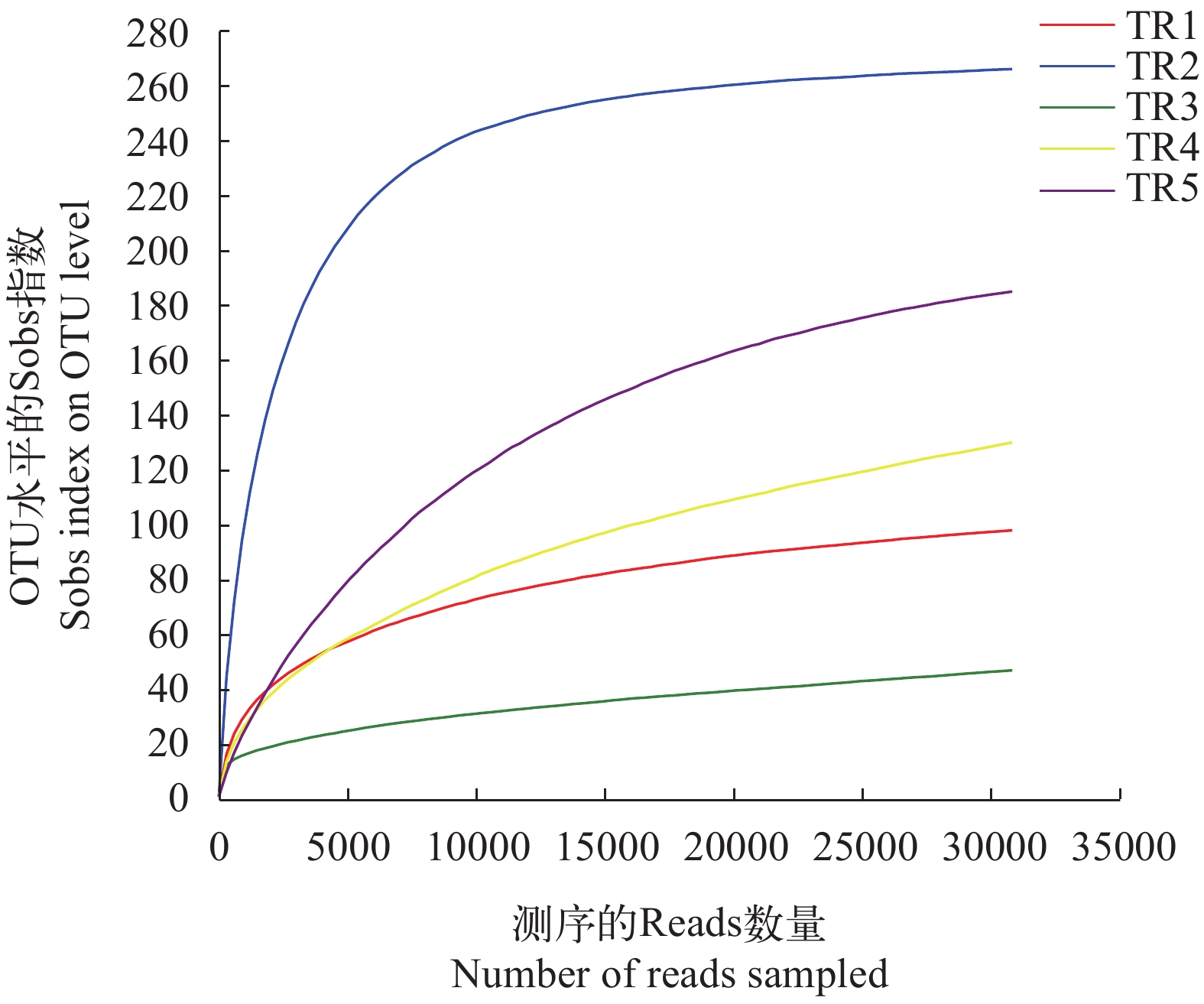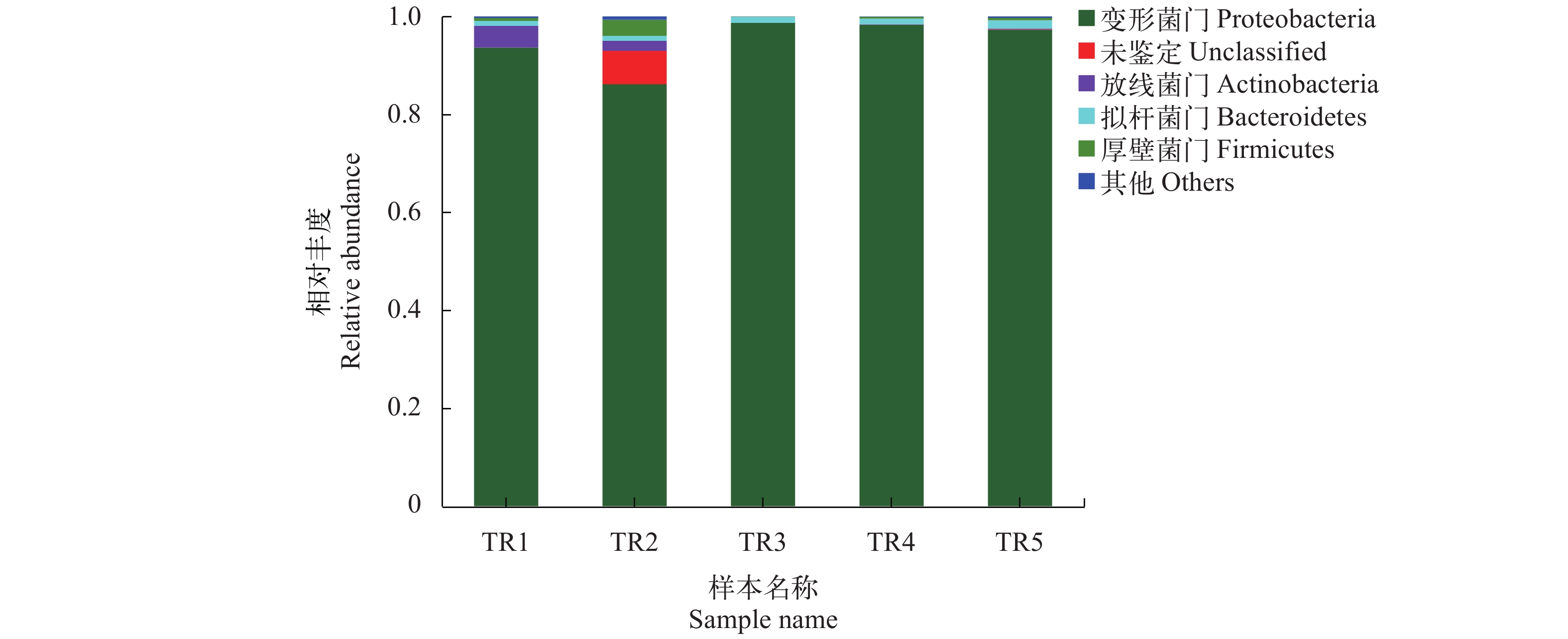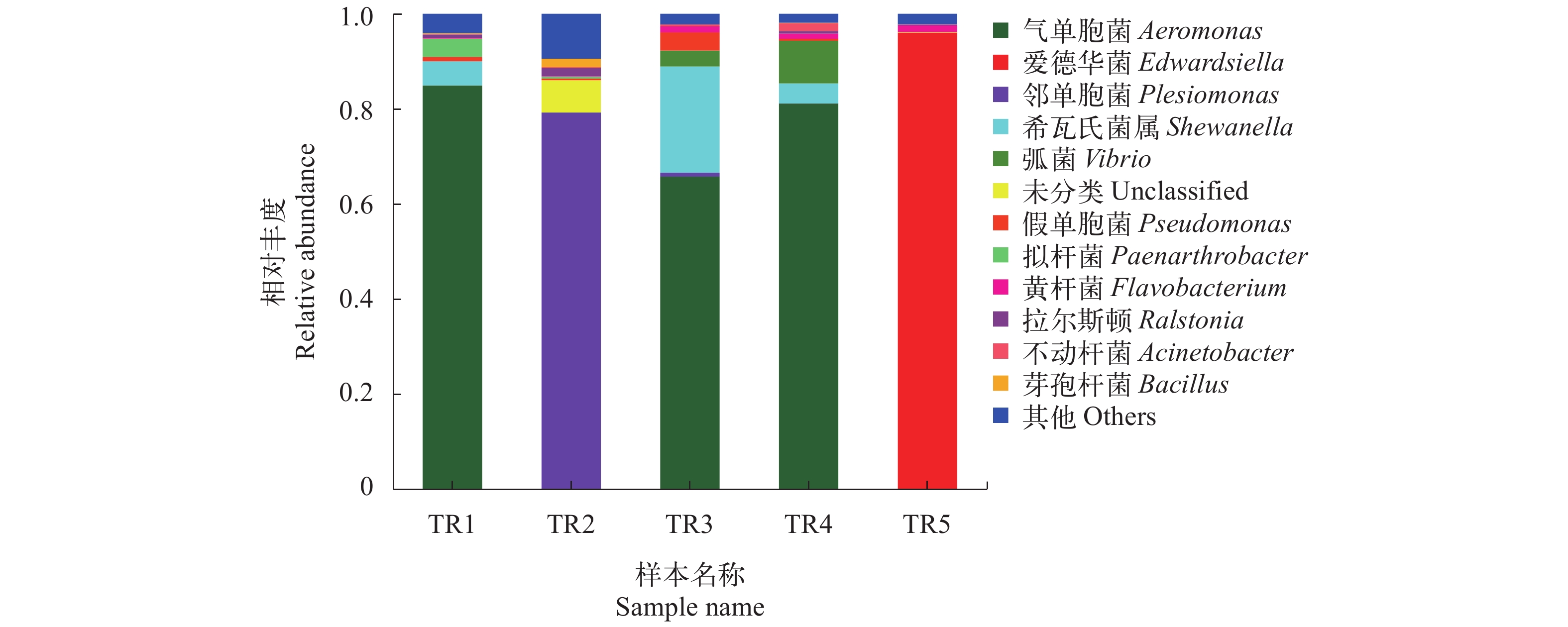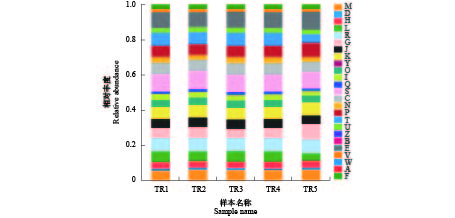ANALYSIS OF INTESTINAL MICROORGANISMS IN TRIPLOPHYSA ROSA (TELEOSTEI, CYPRINIFORMES)
-
摘要: 研究旨在分析玫瑰高原鳅(Triplophysa rosa)肠道微生物的结构组成和多样性, 探索其肠道微生物的潜在功能。提取了5尾玫瑰高原鳅的肠道总DNA, 运用Illumina Miseq平台对肠道微生物16S rRNA的V3—V4区进行了测序, 统计样品肠道微生物的操作分类单元(Operational Taxonomic Units, OTUs)数量, 分析物种组成、丰度及Alpha多样性, 并预测肠道微生物的功能。结果显示, 玫瑰高原鳅的肠道微生物有19门、31纲、87目、 146科、253属、 320种, 451个OTUs。在门水平上, 优势菌群为变形菌门(Proteobacteria)、放线菌门(Actinobacteria)和拟杆菌门(Bacteroidetes); 在属水平上, 优势菌群为气单胞菌属(Aeromonas)、爱德华菌属(Edwardsiella)、邻单胞菌属(Plesiomonas)和希瓦氏菌属(Shewanella)。功能预测表明, 肠道微生物编码的大多数基因与新陈代谢相关, 其中“碳水化合物运输和代谢”和“氨基酸转运与代谢”功能类群的相对丰度较高。玫瑰高原鳅肠道内微生物组成复杂, 其功能分析有助于理解肠道微生物对玫瑰高原鳅摄食的影响, 为进一步研究玫瑰高原鳅的食性提供了理论基础。Abstract: Triplophysa rosa is a typical cave-dwelling fish distributed at Wulong County, Chongqing, China. It has degenerated eyes, albino skin, and highly developed sense organs, but its gut microbial function adapted to cave remains to be settled. The aims of this study were to analyze the structure and diversity of intestinal microorganisms in T. rosa and to explore the function of intestinal microorganisms. We extracted total intestinal DNA of 5 T. rosa, and then sequenced the V3—V4 region of 16S rRNA using Illumina Miseq sequencing technology. The number of operational taxonomic units (OTUs) of intestinal microorganisms was counted to analyze species composition, abundance, and Alpha diversity. The function of intestinal microorganisms was predicted by PICRUSt. A total of 451 OTUs of the high-quality sequences were obtained, belonging to 19 phyla, 31 classes, 87 orders, 146 families, 253 genera, and 320 species. At the phylum level, Proteobacteria, Actinobacteria, and Bacteroidetes were the dominant microorganisms. At the genus level, Aeromonas, Edwardsiella, Plesiomonas, and Shewanella were the main microorganisms. Functional prediction showed that most of the genes encoded by intestinal microorganisms are related to metabolism with the highest relationship with “amino acid transport and metabolism” and “carbohydrate transport and metabolism”. The composition of the microorganisms in the intestinal tract of T. rosa is complex, and functional analysis is helpful to understand the influence of intestinal microorganisms on its feeding, providing a theoretical basis for further study on fish diet.
-
Keywords:
- Triplophysa rosa /
- Intestinal microorganisms /
- 16S rRNA /
- Diversity /
- Function
-
-
图 4 基于属水平的玫瑰高原鳅肠道菌群结构
Aeromonas. 气单胞菌属; Edwardsiella. 爱德华菌属; Plesiomonas. 邻单胞菌属; Shewanella. 希瓦氏菌属; Vibrio. 弧菌属; Unclassified. 未鉴定; Pseudomonas. 假单胞菌属; Paenarthrobacter; Flavobacterium. 黄杆菌属; Ralstonia. 罗尔斯通菌属; Acinetobacter. 不动杆菌属; Bacillus. 芽孢杆菌属; Others. 其他
Figure 4. Bacterial structure evaluated at the genus taxonomical level in T. rosa
图 5 玫瑰高原鳅肠道微生物的COG功能分类统计
A. RNA处理和修饰RNA processing and modification; B. 染色质结构与动力学Chromatin structure and dynamics; C. 能源生产与转化Energy production and conversion; D. 细胞周期控制、细胞分裂、染色体分裂Cell cycle control, cell division, chromosome partitioning; E. 氨基酸转运与代谢Amino acid transport and metabolism; F. 核苷酸的转运和代谢Nucleotide transport and metabolism; G. 碳水化合物运输和代谢Carbohydrate transport and metabolism; H. 辅酶运输和代谢Coenzyme transport and metabolism; I. 脂质转运与代谢Lipid transport and metabolism; J. 翻译、核糖体结构和生物发生Translation, ribosomal structure and biogenesis; K. 转录终止Transcription termination; L. 复制、重组和修复Replication, recombination and repair; M. 细胞壁/膜/信封生源论Cell wall/membrane/envelope biogenesis; N. 细胞运动Cell motility; O. 翻译后修饰、蛋白质周转、伴侣Posttranslational modification, protein turnover, chaperones; P. 无机离子运输与代谢Inorganic ion transport and metabolism; Q. 次生代谢产物的合成、运输和分解代谢Secondary metabolites biosynthesis, transport and catabolism; R. 一般功能预测General function prediction only; S. 功能未知Function unknown; T. 信号转导机制Signal transduction mechanisms; U. 细胞内运输、分泌和囊泡运输Intracellular trafficking, secretion, and vesicular transport; V. 防御机制Defense mechanisms; W. 真核细胞的细胞外结构Extracellular structures; Y. 核结构Nuclear structure; Z. 细胞骨架Cytoskeleton
Figure 5. The COG function classification of intestinal microorganisms in T. rosa
表 1 Alpha多样性统计
Table 1 The statistics of Alpha-diversity
样本编号Sample number 香农指数Shannon index 辛普森指数Simpson index ACE指数ACE index Chao1 指数Chao1 index 覆盖率Coverage TR1 0.823 0.725 115.433 121.100 0.999 TR2 1.505 0.626 268.554 272.875 1.000 TR3 1.169 0.478 124.584 89.750 0.999 TR4 0.868 0.668 184.968 186.000 0.998 TR5 0.325 0.919 208.514 198.232 0.999 注: TR为玫瑰高原鳅拉丁文名的缩写, 其后的数字表示样本编号Note: TR. Triplophysa rosa, the number behind TR means sample number 表 2 KEGG代谢通路统计
Table 2 Metabolic pathway statistics based on KEGG
编号Number 功能Function 丰度Abundance 1 新陈代谢Metabolism 45059885 2 环境信息处理Environmental information processing 17740636 3 遗传信息处理Genetic information processing 15714193 4 细胞进程Cellular processes 5518399 5 人类疾病;Human diseases 1146337 6 有机系统Organismal systems 672877 7 无None 195855 -
[1] Chen X Y, Yang J X. Triplophysa rosa sp. nov.: a new blind loach from China [J]. Journal of Fish Biology, 2005, 66(3): 599-608. doi: 10.1111/j.0022-1112.2005.00622.x
[2] 黄静, 彭作刚, 王志坚. 贝氏高原鳅与玫瑰高原鳅脑大体解剖结构的比较 [J]. 西南师范大学学报(自然科学版), 2013, 38(3): 94-100. Huang J, Peng Z G, Wang Z J. Comparison of the gross anatomy of the brains between Triplophysa bleekeri and Triplophysa rosa [J]. Journal of Southwest China Normal University (
Natural Science Edition ) , 2013, 38(3): 94-100. [ [3] 牛亚兵. 玫瑰高原鳅和贝氏高原鳅视觉器官比较组织学研究 [D]. 重庆: 西南大学, 2017: 19-35. Niu Y P. Comparative histological study of visual organs between Triplophysa rosa and Triplophysa bleekeri [D]. Chongqing: Southwest University, 2017: 19-35.
[4] 肖颖琦. 玫瑰高原鳅体色白化的遗传学基础研究 [D]. 重庆: 西南大学, 2017: 16-18 Xiao Y Q. Genetic basis of the albinism in the cavefish Triplophysa rosa [D]. Chongqing: Southwest University, 2017: 16-18.
[5] Shi C, Yao M, Lv X, et al. Body and organ metabolic rates of a cave fish, Triplophysa rosa: influence of light and ontogenetic variation [J]. Journal of Comparative Physiology B, 2018, 188(6): 947-955. doi: 10.1007/s00360-018-1178-x
[6] Wang J, Tang Q, Wang Z, et al. The complete mitogenome sequence of a cave loach Triplophysa rosa (Teleostei, Balitoridae, Nemacheilinae) [J]. Mitochondrial DNA, 2012, 23(5): 366-368. doi: 10.3109/19401736.2012.696628
[7] Zhao J, Zhao K, Peng Z. Development and characterization of eleven microsatellite markers for an endangered cavefish (Triplophysa rosa Chen and Yang, 2005) using 454 sequencing [J]. Journal of Applied Ichthyology, 2014, 30(5): 1056-1058. doi: 10.1111/jai.12474
[8] 赵金凤. 玫瑰高原鳅保护遗传学研究 [D]. 重庆: 西南大学, 2015: 27-32 Zhao J F. Conservation genetics of Triplophysa rosa (Teleostei: Cypriniformes) [D]. Chongqing: Southwest University, 2015: 27-32.
[9] 殷名称. 鱼类生态学 [M]. 北京: 中国农业出版社, 1995: 64-78. Yin M C. Fish Ecology [M]. Beijing: China Agriculture Press, 1995: 64-78
[10] Baldo L, Pretus J L, Riera J L, et al. Convergence of gut microbiotas in the adaptive radiations of African cichlid fishes [J]. The ISME Journal, 2017, 11(9): 1975-1987. doi: 10.1038/ismej.2017.62
[11] Blaser M J. The microbiome revolution [J]. Journal of Clinical Investigation, 2014, 124(10): 4162-4165. doi: 10.1172/JCI78366
[12] Nayak S K. Role of gastrointestinal microbiota in fish [J]. Aquaculture Research, 2010, 41(11): 1553-1573. doi: 10.1111/j.1365-2109.2010.02546.x
[13] 蔡斌斌. 白甲鱼肠道微生物多样性及其功能分析 [D]. 福州: 福建师范大学, 2017: 2 Cai B B. Diversity and function analysis of the intestine microbes of Onychostoma sima [D]. Fuzhou: Fujian Normal University, 2017: 2.
[14] Li J, Ni J, Li J, et al. Comparative study on gastrointestinal microbiota of eight fish species with different feeding habits [J]. Journal of Applied Microbiology, 2014, 117(6): 1750-1760. doi: 10.1111/jam.12663
[15] Ward N L, Steven B, Penn K, et al. Characterization of the intestinal microbiota of two Antarctic notothenioid fish species [J]. Extremophiles, 2009, 13(4): 679-685. doi: 10.1007/s00792-009-0252-4
[16] 郁二蒙, 张振男, 夏耘, 等. 摄食不同饵料的大口黑鲈肠道菌群分析 [J]. 水产学报, 2015, 39(1): 118-126. Yu E M, Zhang Z N, Xia Y, et al. Effects of different diets on intestinal microflora of largemouth bass (Micropterus salmoides) [J]. Journal of Fisheries of China, 2015, 39(1): 118-126. [
[17] 钟蕾, 向建国, 曾丹, 等. 饵料对鳡肠道微生物多样性的影响 [J]. 水生生物学报, 2016, 40(4): 830-835. doi: 10.7541/2016.107 Zhong L, Xiang J G, Zeng D, et al. Effects of different diets on intestinal microbiota of Elopichthys bambusa [J]. Acta Hydrobiologica Sinica, 2016, 40(4): 830-835. [ doi: 10.7541/2016.107
[18] Ley R E, Lozupone C A, Hamady M, et al. Worlds within worlds: evolution of the vertebrate gut microbiota [J]. Nature Reviews Microbiology, 2008, 6(10): 776-788. doi: 10.1038/nrmicro1978
[19] Liu H, Guo X, Gooneratne R, et al. The gut microbiome and degradation enzyme activity of wild freshwater fishes influenced by their trophic levels [J]. Scientific Reports, 2016(6): 24340. doi: 10.1038/srep24340
[20] Pan Q, Shai O, Lee L J, et al. Deep surveying of alternative splicing complexity in the human transcriptome by high-throughput sequencing [J]. Nature Genetics, 2008, 40(12): 1413-1415. doi: 10.1038/ng.259
[21] Xu N, Tan G, Wang H, et al. Effect of biochar additions to soil on nitrogen leaching, microbial biomass and bacterial community structure [J]. European Journal of Soil Biology, 2016(74): 1-8. doi: 10.1016/j.ejsobi.2016.02.004
[22] Smith P, Willemsen D, Popkes M, et al. Regulation of life span by the gut microbiota in the short-lived African turquoise killifish [J]. eLife, 2017(6): e27014. doi: 10.7554/eLife.27014
[23] Pafčo B, Sharma A K, Petrželková K J, et al. Gut microbiome composition of wild western lowland gorillas is associated with individual age and sex factors [J]. American Journal of Physical Anthropology, 2019, 169(3): 575-585. doi: 10.1002/ajpa.23842
[24] 石萍, 鲁增辉, 游华建, 等. 饥饿及恢复喂食对日本医蛭肠道菌群多样性的影响 [J]. 水生生物学报, 2019, 43(3): 537-544. doi: 10.7541/2019.065 Shi P, Lu Z H, You H J, et al. Effects of fasting and refeeding on Hirudo medicinalis intestinal microflora diversity [J]. Acta Hydrobiologica Sinica, 2019, 43(3): 537-544. [ doi: 10.7541/2019.065
[25] Mekuchi M, Asakura T, Sakata K, et al. Intestinal microbiota composition is altered according to nutritional biorhythms in the leopard coral grouper (Plectropomus leopardus) [J]. PLoS One, 2018, 13(6): e0197256. doi: 10.1371/journal.pone.0197256
[26] 熊向英, 王贤丰, 彭银辉, 等. 健康和患病卵形鲳鲹肠道菌群结构的差异 [J]. 水产学报, 2019, 43(5): 1317-1325. Xiong X Y, Wang X F, Peng Y H, et al. Variance analysis of intestinal bacterial community between healthy and diseased Tranchinotus ovatus [J]. Journal of Fisheries of China, 2019, 43(5): 1317-1325. [
[27] Sun Y, Zhang M, Chen C C, et al. Stress-induced corticotropin-releasing hormone-mediated NLRP6 inflammasome inhibition and transmissible enteritis in mice [J]. Gastroenterology, 2013, 144(7): 1478-1487. doi: 10.1053/j.gastro.2013.02.038
[28] Michl S C, Ratten J M, Beyer M, et al. The malleable gut microbiome of juvenile rainbow trout (Oncorhynchus mykiss): Diet-dependent shifts of bacterial community structures [J]. PLoS One, 2017, 12(5): e0177735. doi: 10.1371/journal.pone.0177735
[29] Dehler C E, Secombes C J, Martin S A M. Seawater transfer alters the intestinal microbiota profiles of Atlantic salmon (Salmo salar L.) [J]. Scientific Reports, 2017, 7(1): 13877. doi: 10.1038/s41598-017-13249-8
[30] Zheng X, Yang R, Hu J, et al. The gut microbiota community and antioxidant enzymes activity of barramundi reared at seawater and freshwater [J]. Fish and Shellfish Immunology, 2019(89): 127-131. doi: 10.1016/j.fsi.2019.03.054
[31] Ornelas-García P, Pajares S, Sosa-Jiménez V M, et al. Microbiome differences between river-dwelling and cave-adapted populations of the fish Astyanax mexicanus (De Filippi, 1853) [J]. PeerJ, 2018, 6(2): e5906.
[32] Roeselers G, Mittge E K, Stephens W Z, et al. Evidence for a core gut microbiota in the zebrafish [J]. The ISME Journal, 2011, 5(10): 1595-1608. doi: 10.1038/ismej.2011.38
[33] Gruninger R J, Sensen C W, McAllister T A, et al. Diversity of rumen bacteria in Canadian cervids [J]. PLoS One, 2014, 9(2): e89682. doi: 10.1371/journal.pone.0089682
[34] 沈佳斌, 张雪敬, 吴蔚, 等. 雉科鸟类肠道微生物的多样性与功能及其对食性的适应 [J]. 南京师大学报(自然科学版), 2016, 39(2): 90-95. Shen J B, Zhang X J, Wu W, et al. The gut microbes’ diversity and function of Phasianidae provide insights on the adaptation to their diet [J]. Journal of Nanjing Normal University (
Natural Science Edition ) , 2016, 39(2): 90-95. [ [35] Qin Z, Wang S, Guo D, et al. Comparative analysis of intestinal bacteria among venom secretion and non-secrection snakes [J]. Scientific Reports, 2019, 9(1): 6335. doi: 10.1038/s41598-019-42787-6
[36] Briones-Roblero C I, Hernández-García J A, Gonzalez-Escobedo R, et al. Structure and dynamics of the gut bacterial microbiota of the bark beetle, Dendroctonus rhizophagus (Curculionidae: Scolytinae) across their life stages [J]. PLoS One, 2017, 12(4): e0175470. doi: 10.1371/journal.pone.0175470
[37] Kersters K, Vos P D, Gillis M, et al. Introduction to the Proteobacteria [M]. New York: Springer, 2006: 3-37
[38] Bäckhed F, Ding H, Wang T, et al. The gut microbiota as an environmental factor that regulates fat storage [J]. Proceedings of the National Academy of Sciences of the United States of America, 2004, 101(44): 15718-15723. doi: 10.1073/pnas.0407076101
[39] 向毅, 巫贵成. 肠道微生态的基本概念 [J]. 现代医药卫生, 2019, 35(1): 5-7. doi: 10.3969/j.issn.1009-5519.2019.01.002 Xiang Y, Wu G C. Some concepts of intestinal microbiota [J]. Modern Medicine Health, 2019, 35(1): 5-7. [ doi: 10.3969/j.issn.1009-5519.2019.01.002
[40] Nuriel-Ohayon M, Neuman H, Koren O. Microbial changes during pregnancy, birth, and infancy [J]. Frontiers in Microbiology, 2016(7): 1031.
[41] Pemberton J M, Kidd S P, Schmidt R. Secreted enzymes of Aeromonas [J]. FEMS Microbiology Letters, 1997, 152(1): 1-10. doi: 10.1111/j.1574-6968.1997.tb10401.x
[42] 陈翠珍. 爱德华氏菌及鱼类爱德华氏菌病(综述) [J]. 河北科技师范学院学报, 2004, 18(3): 70-76. doi: 10.3969/j.issn.1672-7983.2004.03.018 Chen C Z. Edwardsiella and Edwardsiellasis of fish (Summary) [J]. Journal of Hebei Normal University of Science & Technology, 2004, 18(3): 70-76. [ doi: 10.3969/j.issn.1672-7983.2004.03.018
[43] Brugman S, Nieuwenhuis E E. Mucosal control of the intestinal microbial community [J]. Journal of Molecular Medicine, 2010, 88(9): 881-888. doi: 10.1007/s00109-010-0639-9
[44] Cerf-Bensussan N, Gaboriau-Routhiau V. The immune system and the gut microbiota: friends or foes [J]? Nature Reviews Immunology, 2010, 10(10): 735-744. doi: 10.1038/nri2850
[45] Viney M E, Riley E M. From Immunology to Eco-immunology: More Than a New Name [M]. Netherlands: Springer, 2014: 1-13




 下载:
下载:



